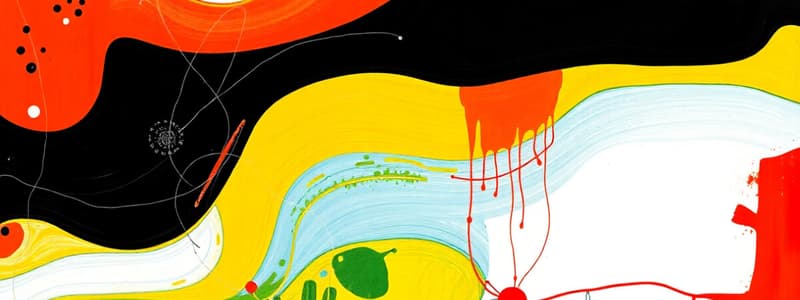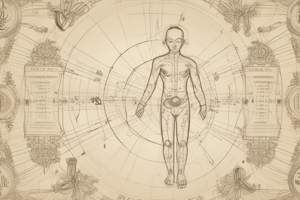Podcast
Questions and Answers
What is the crucial distinction highlighted in the definition of creativity?
What is the crucial distinction highlighted in the definition of creativity?
- Its manifestation in artistic endeavors
- Its dependence on external validation
- Its outcome being both novel and practical (correct)
- Its reliance on complex cognitive processes
How does the 'incubation' stage contribute to the creative process?
How does the 'incubation' stage contribute to the creative process?
- It requires conscious and focused attention on solving a problem
- It allows for subconscious processing while attention is diverted (correct)
- It represents the immediate implementation of a creative idea
- It involves intensive research and data collection on a specific topic
When evaluating creativity using the Alternative Uses Task (AUT), what does 'cognitive flexibility' measure?
When evaluating creativity using the Alternative Uses Task (AUT), what does 'cognitive flexibility' measure?
- The total amount of ideas generated by participants.
- The speed at which participants can come up with different ideas.
- The diversity of categories to which participants' ideas belong. (correct)
- The originality of the ideas generated by participants.
In the context of the Alternative Uses Task (AUT), what is the primary method for calculating the 'average uniqueness score'?
In the context of the Alternative Uses Task (AUT), what is the primary method for calculating the 'average uniqueness score'?
What critical perspective challenges the common belief about the brain's hemispheres in relation to creativity?
What critical perspective challenges the common belief about the brain's hemispheres in relation to creativity?
How does 'mind-wandering' relate to the neural basis of creativity during incubation?
How does 'mind-wandering' relate to the neural basis of creativity during incubation?
What role do the Default Mode Network (DMN) and Cognitive Control Network (CCN) play in the neural basis of creativity?
What role do the Default Mode Network (DMN) and Cognitive Control Network (CCN) play in the neural basis of creativity?
Which association accurately describes the brainwave activity correlated with insight?
Which association accurately describes the brainwave activity correlated with insight?
How does the bilateral hippocampus contribute to creative thinking, as suggested by research?
How does the bilateral hippocampus contribute to creative thinking, as suggested by research?
How does personality interact with IQ in influencing individual differences in creativity?
How does personality interact with IQ in influencing individual differences in creativity?
What complications were discovered in the experiment involving microdosing with psilocybin mushrooms?
What complications were discovered in the experiment involving microdosing with psilocybin mushrooms?
How does the 'anarchic brain' model (REBUS) explain the acute effects of psilocybin on brain function?
How does the 'anarchic brain' model (REBUS) explain the acute effects of psilocybin on brain function?
What does the 'cultural niche' hypothesis suggest about the evolution of technology?
What does the 'cultural niche' hypothesis suggest about the evolution of technology?
How did inheriting a theory influence participants' understanding of a physical problem?
How did inheriting a theory influence participants' understanding of a physical problem?
If a study aimed to improve creativity through interventions that target cognitive processes, which approach would be most aligned with current understanding?
If a study aimed to improve creativity through interventions that target cognitive processes, which approach would be most aligned with current understanding?
What is the implication of the Alternative Uses Task (AUT) in examining creativity?
What is the implication of the Alternative Uses Task (AUT) in examining creativity?
Assuming you aim to design an environment optimal for creative incubation, which characteristic is most crucial based on neural insights?
Assuming you aim to design an environment optimal for creative incubation, which characteristic is most crucial based on neural insights?
How might interventions to enhance creativity leverage the interaction between the Default Mode Network (DMN) and the Cognitive Control Network (CCN)?
How might interventions to enhance creativity leverage the interaction between the Default Mode Network (DMN) and the Cognitive Control Network (CCN)?
What key distinction differentiates the 'cognitive niche' from the 'cultural niche' in driving human advancement?
What key distinction differentiates the 'cognitive niche' from the 'cultural niche' in driving human advancement?
Why might relying heavily on inherited 'theories' potentially impede innovation, based on evidence presented?
Why might relying heavily on inherited 'theories' potentially impede innovation, based on evidence presented?
What strategies would best leverage both the cognitive and cultural aspects of creativity to foster innovation?
What strategies would best leverage both the cognitive and cultural aspects of creativity to foster innovation?
What distinguishes the 'preparation' stage of the creative procedure?
What distinguishes the 'preparation' stage of the creative procedure?
What role does the medial prefrontal cortex (MPFC) play as part of the Default Mode Network (DMN) during creative incubation?
What role does the medial prefrontal cortex (MPFC) play as part of the Default Mode Network (DMN) during creative incubation?
Psilocybin can have various effects on the Default Mode Network (DMN). Which effect has been noted when researching psilocybin?
Psilocybin can have various effects on the Default Mode Network (DMN). Which effect has been noted when researching psilocybin?
Flashcards
Creativity Definition
Creativity Definition
The process of bringing into being something that is both new and useful.
Preparation (Creative Process)
Preparation (Creative Process)
Acquisition of knowledge to some task.
Incubation (Creative Process)
Incubation (Creative Process)
Process that occurs when conscious attention is diverted away from the task.
Illumination (Creative Process)
Illumination (Creative Process)
Signup and view all the flashcards
Verification (Creative Process)
Verification (Creative Process)
Signup and view all the flashcards
Alternative Uses Task
Alternative Uses Task
Signup and view all the flashcards
Cognitive Flexibility
Cognitive Flexibility
Signup and view all the flashcards
Average Uniqueness Score
Average Uniqueness Score
Signup and view all the flashcards
Brain regions and creativity.
Brain regions and creativity.
Signup and view all the flashcards
Mind-wandering
Mind-wandering
Signup and view all the flashcards
Default Mode Network (DMN)
Default Mode Network (DMN)
Signup and view all the flashcards
Cognitive Control Network (CCN)
Cognitive Control Network (CCN)
Signup and view all the flashcards
Cognitive Niche vs Cultural Niche
Cognitive Niche vs Cultural Niche
Signup and view all the flashcards
Study Notes
Defining Creativity
- Creativity explains the set of covarying observed behaviours
- Creativity is the process of bringing something new and useful into being, per Ritter et al. (2012)
Temporal Dynamics of Creative Process
- Preparation involves acquiring knowledge for a task
- Incubation is a process where conscious attention is diverted away from a task
- Illumination is when a creative idea flashes into sight
- Verification is when a creative idea is subjected to evaluation
Measurement of Creativity
- Alternative Uses Task was developed by Guilford in 1967
- This task involves thinking of alternative uses for a common object, such as a brick
- People are given 2 minutes to respond in the Alternative Uses Task
- Cognitive Flexibility is the total number of different categories that a participant's ideas belonged to
- Average uniqueness score is the frequency of an idea relative to the total named ideas
- Average creativity score is on a five-point scale from "not at all creative" to "extremely creative"
Neural Basis of Creativity
- The left and right brain myth is incorrect
- Neural activity occurs in many regions of the brain, in both hemispheres, during creative tasks
- Meta-analysis shows incubation has positive effects on creativity per Dodds et al (2003) and Sio & Omerod (2009)
- Mind-wandering is a spontaneous state when an awake individual is not engaged in a demanding task
- Sleep, especially REM sleep, is linked to creativity
- Inter- and anti-correlated brain networks are also invovled
Brain Networks for Creativity: Incubation
- DMN (Default Mode Network) includes the medial prefrontal cortex (MPFC), posterior cingulate cortex (PCC), and lateral and medial temporal lobes
- CCN (Cognitive Control Network) includes the anterior cingulate cortex (ACC), dorsolateral prefrontal cortex (DLPFC), inferior frontal junction (IFJ), anterior insular cortex (AIC), dorsal pre-motor cortex (dPMC), and posterior parietal cortex (PPC)
Task Negative Regions
- Task-negative (DMN) regions include medial prefrontal cortex (MPF)
- DMN also includes posterior cingulate/precuneus (PCC)
- DMN also includes lateral parietal cortex (LP)
Task Positive Regions
- Task-positive (CCN) regions include intraparietal sulcus (IPS)
- CCNalso includes frontal eye field region of the precentral sulcus (FEF)
- CCN also includes middle temporal region (MT)
More on Neural Basis of Creativity
- Mixed findings are indicated in reviews by Dietrich & Kanso (2010) and Sawyer (2011)
- Creativity may be a particular application of everyday cognitive processes as indicated by Beaty et al (2018)
- Episodic Memory + Imagination + Creative Thinking can activate the bilateral hippocampus
- The brain region that supports memory supports the ability to imagine and create
Individual Differences in Creativity
- ID Factors include IQ and personality
- Explanatory Power accounts for 32.6% of variance
Interventions in Creativity Study
- Microdosing with psilocybin mushrooms was studied in a double-blind placebo-controlled study with N = 34
- Outcomes were measured based on subjective experience, behaviour, creativity, divergent and convergent thinking, perception, cognition, and brain activity
- There were reported acute expectation effects where the active dose was greater than placebo
- Study participants had to identify the experimental condition they were in
- Enhanced well-being, creativity and cognitive function were not supported and showed a trend towards cognitive impairment
Psilocybin Effect on Default Mode Network
- Psilocybin's effects on the default mode network show mixed findings
- Psilocybin's BOLD activity decreases
- Psilocybin's Functional connectivity decreases
- Psilocybin's Gamma Power increases
Cultural Evolution
- Cultural evolution can be thought of as the cognitive niche vs cultural niche
- In cultural evolution intelligence is gradual accretion of knowledge
- Causal understanding is not necessary for the improvement of culturally evolving technology
Theory Transmission
- Participants who did not inherit any theory generated a greater range of wheels
- Inheriting one theory increased understanding of it, but reduced understanding of the other
- Effects were performance-neutral for this 2-D problem
- For >D problems, better understanding of one dimension is unlikely to compensate for worse understanding of all of the others
Studying That Suits You
Use AI to generate personalized quizzes and flashcards to suit your learning preferences.




